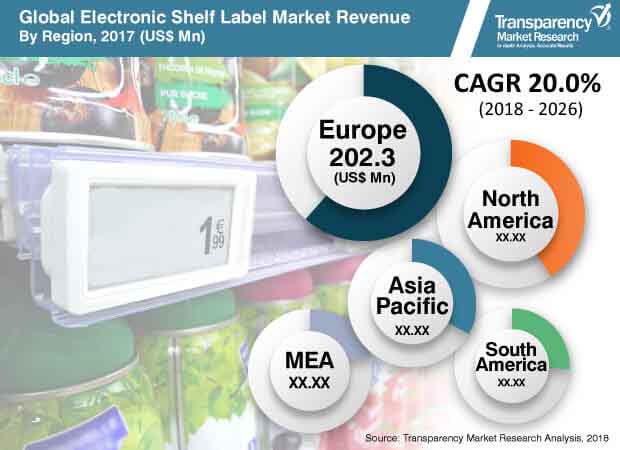Electronic Shelf Label Market is expanding at a CAGR of 20.0% from 2018 to 2026
According to a new market report titled “Electronic Shelf Label (ESL) Market-Global Industry Analysis, Size, Share, Growth, Trends, and Forecast 2018 – 2026″, published by Transparency Market Research, the global electronic shelf label market is expected to reach US$ 2,517.9 Mn by 2026, expanding at a CAGR of 20.0% from 2018 to 2026. According to the report, the global market is expected to continue to be influenced by a range of macroeconomic and industry-specific factors. Europe is anticipated to continue to be at the forefront of global demand, with the market in the region expanding at a CAGR of above 19.4% during the forecast period. Technical advancements, increased digitization, and presence of a large number of electronic shelf label hardware, software, and service providers are anticipated to drive the electronic shelf label market in Europe.

Rising Significance of Automation in Retail Industry and Technological Advancement across the World Driving the Global Electronic Shelf Label Market
Growing adoption of store automation and integration of electronic pricing is expected to boost the electronic shelf label market in the coming years. Moreover, technological advancement and stringent regulations against misleading product pricing are likely to drive the growth of the market during the forecast period. Presence of large number of electronic shelf label system providers and post-sale service providers across regions has led to a subsequent rise in demand for electronic shelf labels. This is likely to propel the growth of the market during the forecast period.
In terms of electronic shelf label hardware and software, both Europe and North America are mature regions of the market, due to high awareness about electronic shelf label systems among users and technological developments. However, the market in Asia Pacific is estimated to expand at a robust pace during the forecast period. Rise in penetration of technology as well as significant investments in the optimal utilization of digital pricing systems across countries such as U.K., Germany, France, the U.S., China, India, and Brazil are anticipated to offer lucrative opportunities for electronic shelf label system providers in the near future.
For More Details, Request A Sample Report@ https://www.transparencymarketresearch.com/sample/sample.php?flag=S&rep_id=16418
Electronic Shelf Label Market: Scope of the Report
Based on component, the global electronic shelf label market has been segmented into hardware, software, and services. The hardware segment held a significant market share and is anticipated to remain dominant over the forecast period in terms of revenue. The hardware segment has been further divided into labels (product) type and infrastructure. The labels (product) type based sub-segment accounted for a prominent market share globally, followed by the infrastructure sub-segment, in terms of revenue.
Labels (product) type segment is categorized into LCD ESL, segmented E-paper ESL, and full-graphic E-paper ESL. Among these, both LCD ESL and full-graphic E-paper ESL are witnessing prominence in the electronic shelf label market. Moreover, the adoption rate of full graphic E-paper ESL among retailers has gained rapid prominence and is projected to expand at a significant pace over the forecast period due to its low power consumption, high visibility, and paper like display.
Based on communication technology, the radio frequency (RF) technology segment accounted for a major share of the global market in 2017 due to its extensive usage in diversified technology segments such as Wi-Fi, Bluetooth Low Energy, ZigBee, and Z-wave, followed by the infrared (IR) technology and near field communication (NFC) segment. As per the research study, the near field communication (NFC) technology segment is projected to expand at a rapid pace between 2018 and 2026 because of its growing adoption in devices such as smartphones and POS systems and it reduces the overall installation cost of these labels.